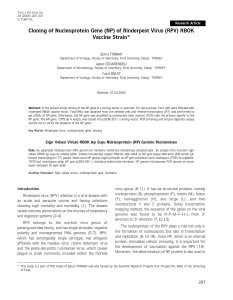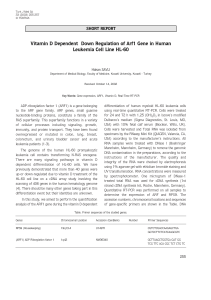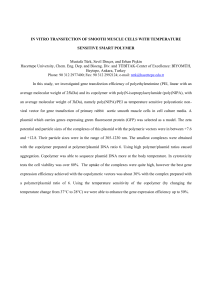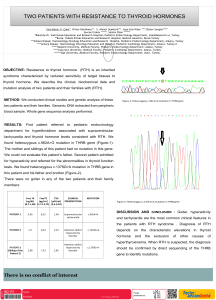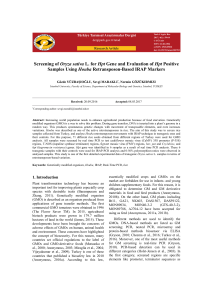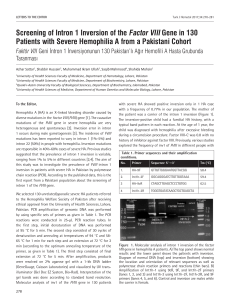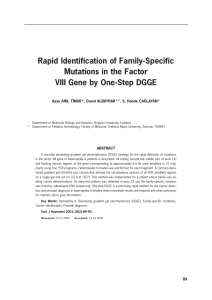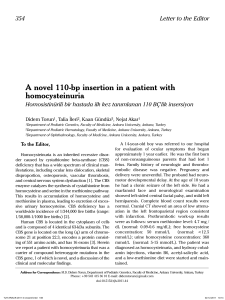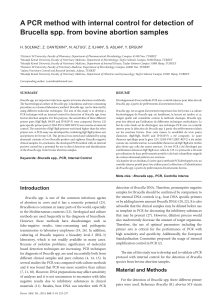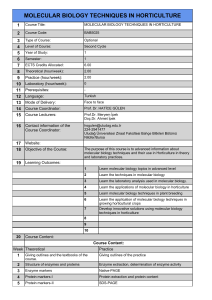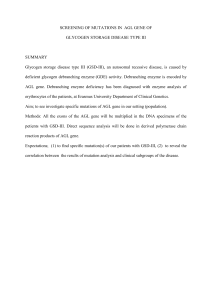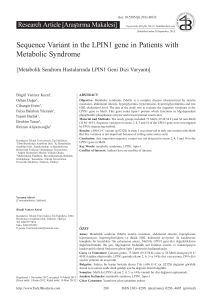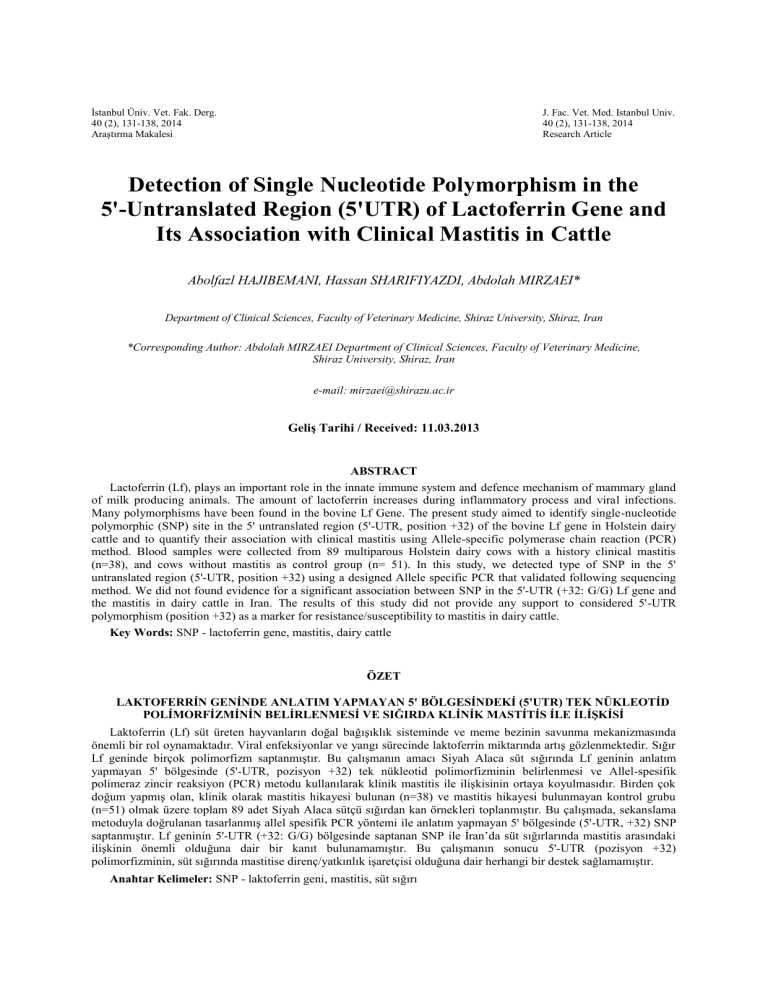
İstanbul Üniv. Vet. Fak. Derg.
40 (2), 131-138, 2014
Araştırma Makalesi
J. Fac. Vet. Med. Istanbul Univ.
40 (2), 131-138, 2014
Research Article
Detection of Single Nucleotide Polymorphism in the
5'-Untranslated Region (5'UTR) of Lactoferrin Gene and
Its Association with Clinical Mastitis in Cattle
Abolfazl HAJIBEMANI, Hassan SHARIFIYAZDI, Abdolah MIRZAEI*
Department of Clinical Sciences, Faculty of Veterinary Medicine, Shiraz University, Shiraz, Iran
*Corresponding Author: Abdolah MIRZAEI Department of Clinical Sciences, Faculty of Veterinary Medicine,
Shiraz University, Shiraz, Iran
e-mail: [email protected]
Geliş Tarihi / Received: 11.03.2013
ABSTRACT
Lactoferrin (Lf), plays an important role in the innate immune system and defence mechanism of mammary gland
of milk producing animals. The amount of lactoferrin increases during inflammatory process and viral infections.
Many polymorphisms have been found in the bovine Lf Gene. The present study aimed to identify single-nucleotide
polymorphic (SNP) site in the 5' untranslated region (5'-UTR, position +32) of the bovine Lf gene in Holstein dairy
cattle and to quantify their association with clinical mastitis using Allele-specific polymerase chain reaction (PCR)
method. Blood samples were collected from 89 multiparous Holstein dairy cows with a history clinical mastitis
(n=38), and cows without mastitis as control group (n= 51). In this study, we detected type of SNP in the 5'
untranslated region (5'-UTR, position +32) using a designed Allele specific PCR that validated following sequencing
method. We did not found evidence for a significant association between SNP in the 5'-UTR (+32: G/G) Lf gene and
the mastitis in dairy cattle in Iran. The results of this study did not provide any support to considered 5'-UTR
polymorphism (position +32) as a marker for resistance/susceptibility to mastitis in dairy cattle.
Key Words: SNP - lactoferrin gene, mastitis, dairy cattle
ÖZET
LAKTOFERRİN GENİNDE ANLATIM YAPMAYAN 5' BÖLGESİNDEKİ (5'UTR) TEK NÜKLEOTİD
POLİMORFİZMİNİN BELİRLENMESİ VE SIĞIRDA KLİNİK MASTİTİS İLE İLİŞKİSİ
Laktoferrin (Lf) süt üreten hayvanların doğal bağışıklık sisteminde ve meme bezinin savunma mekanizmasında
önemli bir rol oynamaktadır. Viral enfeksiyonlar ve yangı sürecinde laktoferrin miktarında artış gözlenmektedir. Sığır
Lf geninde birçok polimorfizm saptanmıştır. Bu çalışmanın amacı Siyah Alaca süt sığırında Lf geninin anlatım
yapmayan 5' bölgesinde (5'-UTR, pozisyon +32) tek nükleotid polimorfizminin belirlenmesi ve Allel-spesifik
polimeraz zincir reaksiyon (PCR) metodu kullanılarak klinik mastitis ile ilişkisinin ortaya koyulmasıdır. Birden çok
doğum yapmış olan, klinik olarak mastitis hikayesi bulunan (n=38) ve mastitis hikayesi bulunmayan kontrol grubu
(n=51) olmak üzere toplam 89 adet Siyah Alaca sütçü sığırdan kan örnekleri toplanmıştır. Bu çalışmada, sekanslama
metoduyla doğrulanan tasarlanmış allel spesifik PCR yöntemi ile anlatım yapmayan 5' bölgesinde (5'-UTR, +32) SNP
saptanmıştır. Lf geninin 5'-UTR (+32: G/G) bölgesinde saptanan SNP ile İran’da süt sığırlarında mastitis arasındaki
ilişkinin önemli olduğuna dair bir kanıt bulunamamıştır. Bu çalışmanın sonucu 5'-UTR (pozisyon +32)
polimorfizminin, süt sığırında mastitise direnç/yatkınlık işaretçisi olduğuna dair herhangi bir destek sağlamamıştır.
Anahtar Kelimeler: SNP - laktoferrin geni, mastitis, süt sığırı
132
Introduction
Inflammatory conditions of the udder
(mastitis) represent a major problem in dairy
cattle management. It is the most costly disease
for dairy cattle. Producers suffer a huge loss
due to veterinary treatment costs or, in some
cases, necessary culling of the infected animals.
The milk of cows afflicted with mastitis is not
suitable for consumption, which also leads to a
reduction in the profitability of the production
process (Wojdak-Maksymiec and Kmiec,
2006).
Although advances have been made in
controlling mastitis, but most of the treatments
are still ineffective. Selection of cows for low
somatic cell count has been used to reduce the
incidence of mastitis, but this can also result in
selection of non desirable traits. With
worldwide concern about the use of antibiotics
in farm animal, the development of new
selection techniques are needed to reduce
reliance on antibiotic treatment of mastitis. One
possible solution could be selection of cows
with higher innate levels of antimicrobial
proteins in their milk. This approach has the
potential to reduce the use of antibiotics and
their possible exposure to consumers, while
improving the health of dairy cattle and
profitability of dairy operations (Person et al.,
2007). Lactoferrin (Lf) is a protein which exerts
several functions related to innate immunity. Lf
was first known for its iron chelating properties,
the basis of two of its activities, bacteriostasis
and protection against oxygen radicals
catalyzed by free iron (Legrand et al., 2004). Lf
is a component of the natural protection
systems within the body. Non-specific,
multifunctional Lf is present in milk and such
external secretions of the body as saliva, bile,
tears and sperm. It is released by secondary
granules of neutrophils and epithelial cells in
high
concentrations
in
response
to
inflammatory stimuli (Baggiolini et al., 1970;
Harmon and Newbould, 1980; Plaffl et al.,
2003). Lactoferrin is composed of 690 amino
acids (Zheng et al., 2005). The traditional
functions of lactoferrin are: iron binding
exhibiting growth of bacteria and an iron source
for infants (Tsuji et al., 1989). However, the
Abolfazl Hajibemani, Hassan Sharifiyazdi, Abdolah Mirzaei
bacteriostatic and bactericidal mechanisms of
lactoferrin are very complicated. Lf can bind by
its N-terminal end to the bacterial cell
membrane and increases sensitivity to
lyzosyme, antibodies and antibiotics (Diarra et
al., 2003; Li et al., 2004). The concentration of
Lf in milk from healthy cows is low (0.1–1.0
mg/ml) and rapidly increases in cows with subclinical and clinical mastitis and is positively
correlated with somatic cell count (SCC)higher
SCC
and
higher
lactoferrin
concentrations (Hagiwara et al., 2003; Kawai et
al., 1999). The bovine lactoferrin gene is
located on chromosome 22 spanning
approximately 34.5 kb of genomic DNA and
comprises 17 exons ranging from 82 (exon 1) to
225 bp (exon17) (Zheng et al., 2005). Single
nucleotide polymorphisms (SNPs) are the most
abundant genetic variations in mammalian
genomes, occurring in regulatory, exon and
intron regions of genes (Teng et al., 2006).
Seyfert and Kuhn (1994) found 16
polymorphisms in Lf gene. Lately, Li et al.
(2004) found 3 new SNPs in the promoter
region, and also 4 SNPs in exons 4, 8, 9, 15 and
one in intron 4. None of these SNPs has been
verified as a potential genetic marker for
production traits in dairy cattle. Kaminiski et al.
(2006) found SNP (G/C) in position +32 and
assessed its associations with milk performance
traits, including SCC. The aim of this study was
to identify the single nucleotide polymorphisms
in the region 5'-untranslated region (5'-UTR) of
the lactoferrin gene using Allele-Specific
polymerase chain reaction (PCR) technique and
its relationship with clinical mastitis in Iranian
Holstein dairy cattle.
Materials and Methods
Animal and sample collection
This study was carried out on registered
multiparous Iranian Holstein cattle at the farm
of Farzis milk and meat producing complex in
Shiraz, Fars province, south of Iran. Shiraz is
located at a latitude of 29° 38′ N and longitude
52° 36′ E. Its altitude is 1296 m above sea level.
The climatic condition is relatively rainy mild
winters and hot dry summers with the average
temperature of 17 C ranging between 5 and
Detection of Single Nucleotide Polymorphism in the 5'-Untranslated Region (5'UTR) of Lactoferrin Gene
and Its Association with Clinical Mastitis in Cattle
30 C (Ansari-Lari and Abbasi 2008). The cows
were kept under the same weather and
management conditions in a similar manner.
Cows were fed standard rations (total mixed
ration) including mainly alfalfa, corn silage,
beet pulp, cotton seed, soybean, corn and
barley. The cows were milked three times daily
with the use of a pipeline milking machine.
A total of 89 multiparous Holstein dairy
cows were selected with determined history of
clinical mastitis in the previous lactation. A
total number of 38 cows with clinical mastitis
and 51 cows without clinical mastitis were
selected as case and control groups,
respectively. Blood samples (2 ml) were
collected from each cow via caudal
venipuncture into tubes containing EDTA
anticoagulant and then were sent to the
laboratory and stored at -20º C for subsequent
DNA extraction.
Genomic DNA extraction
Samples were removed from the -20° C
freezer and then were melt and Vortex for 10
seconds. DNA was extracted using a DNA
isolation kit (MBST, Iran) according to the
manufacturer’s instructions. The DNA was
quantified spectrophotometrically, and the
integrity
assessed
via
agarose
gel
electrophoresis (0.8%). Extracted genomic
DNA samples were stored at -20ºC for
subsequent analysis.
Primers
The single nucleotide polymorphisms
(SNPs) in the 5' untranslated region (5'- UTR,
position +32 from transcription start site) of
lactoferrin promoter gene (G/G at Lf +32) were
genotyped using a designed double PCR
amplification of the specific alleles. In the
present study, three primer sets (I, II and III)
were used for PCR. Allel-specific primers
(HajR2, HajF2) for each allele were designed
using the software Primer Premier 5 based on
the +32 area of 5'-UTR lactoferrin gene. All
oligonucleotide primers used in this study were
synthesized by CinnaGen Company in Iran.
Main characteristics of the primers and
133
expected length of produced Fragment by each
pairs of primers are presented in Table 1.
Allele specific PCRs and genotyping
Primer noitmcibmoc II was used to identify
G allele in 5'- UTR and contained primers
HajF2, LFR1-R, Lac-1, Lac-2; primer
noitmcibmoc III also contained four primers
(HajR2, LFR1-F, Lac-1, Lac-2) for detection of
C allele. The PCR reaction (25 μl) was
performed in 10 mM Tris-HCl, pH 8.4, 50 mM
KCl, 1.5 mM MgCl2, 250 μM of each dNTP,
10-20 pmol of each primer (Cinnagen Inc.,
Tehran, Iran), and 0.5 U Taq DNA polymerase
(Fermentas; Glen Burnie, Maryland) using 2 μl
of DNA extracted as template.
Amplification was performed with a BioRad thermocycler (Bio-Rad Laboratories Inc.,
Hercules, CA, USA) by using a single
denaturation step (5 min at 94ºC), followed by a
35-cycle program, with each cycle consisting of
denaturation at 94ºC, for 1 min, annealing at
65-68 ºC for 45 sec, and extension at 72 ºC for
45 sec, with a final extension; a final extension
step (72 ºC for 7 min) was also used. The PCR
products were analyzed by agarose gel
electrophoresis (3%) after ethidium bromide
staining and visualized under ultraviolet
transillumination.
Sequencing
The validity of our designed Allele-specific
PCR was verified by testing 21 individuals
including three polymorphisms. Related PCR
products generated by LFR1-F and LFR2-R
primers (Table 1) were sequenced using
capillary DNA analyzer (ABI 3730, Applied
Biosystems, Foster City, California) after
sequencing reactions with a Big Dye
Terminator V3.1 Cycle Sequencing Kit
(Applied Biosystems). The PCR reaction
condition for primer combination I was the
same as that for two previously described PCR
with primer combination II and III with the
exception of annealing temperature of 57.8 ºC.
Point mutations were screened by DNA
sequence analysis for +32 site in 5'UTR after
multiple alignment using ClustalW alignment
option available in the MEGA 4 software.
134
Abolfazl Hajibemani, Hassan Sharifiyazdi, Abdolah Mirzaei
Table 1.
Characteristics of the specific primers used in PCR.
Tablo 1.
PCR yönteminde kullanılan spesifik primerlerin özellikleri.
Primer
Primer
Combination
I
Primer
Combination
II
Primer
Combination
III
(5`- 3`) Sequence
LFR1-F
5' -GACAGCCTTTGGGCACTTAG-3'
LFR1-R
5' -GGGTAGGACAGAAGCGACAG-3'
HajF2
5'-TTCGTTCCGGAGTCGCCCCAGGAAG-3'
LFR1-R
Lac-1
5'-GGGTAGGACAGAAGCGACAG-3'
5'-GCCTCATGACAACTCCCACAC-3'
Lac-2
5'-CAGGTTGACACATCGGTTGAC-3'
HajR2
5' -GGGGACGAAGAGCTTCATGGCTGTG-3'
LFR1-F
5' -GACAGCCTTTGGGCACTTAG-3'
Lac-1
Lac-2
5' -GCCTCATGACAACTCCCACAC-3'
5' -CAGGTTGACACATCGGTTGAC-3'
Purpose
(references)
Annealing
Temperature
(ºC)
Length
(bp)
Sequencing
(O'Halloran, et
al., 2009)
57.8
1068
G allel specific
detection
(designed in this
study)
(O'Halloran, et
al., 2009)
408
65-68
Internal control
(WojdakMaksymiec and
Kmiec 2006)
301
C allel specific
detection
(designed in this
study)
(O'Halloran, et
al., 2009)
Internal control
709
65-68
(WojdakMaksymiec and
Kmiec, 2006)
301
*The underlined bases are those modified from the original sequence to increase the specificity of the allele-specific PCR
Statistical analysis
The results were analyzed from the aspect of
relationship between the polymorphism within
5' UTR, position +32 of the lactoferrin
promoter region and clinical mastitis. The
results obtained were subjected to statistical
analysis by means of chi-square test for
independence. Three categories of different
mutation types of control (without clinical
mastitis) and patient (with single or more
occurrence clinical mastitis) groups were tested
for significant differences by Pearson ChiSquare test for 2 2 contingency tables. All
results were statistically analyzed at the P≤0.05
level of confidence using the SPSS statistical
software (Version 15.0, SPSS Inc, Chicago,
Illinois).
Results
To identify polymorphism in 5' UTR,
position +32 of the Lf gene, best method of
using Allele Specific PCR consisted two
separate chain reactions that 301 bp product
makes term as internal control. As expected,
Allele Specific PCR analysis of internal PCR
products from different 5' UTR, position +32
genotypes (GG, GC, CC) showed three distinct
banding patterns (Figure 1). As the Allele
Specific PCR method results were completely
consistent with those of the direct sequencing
method in examined samples (Figure 2), we used
this methodology of genotyping for all cases in
this study. GG genotype as wide type show no
mutation in 5' UTR, position +32, whereas GC
and CC genotypes show that mutation is present
in one and both alleles, respectively. According
Detection of Single Nucleotide Polymorphism in the 5'-Untranslated Region (5'UTR) of Lactoferrin Gene
and Its Association with Clinical Mastitis in Cattle
to the double tube allele- specific PCR results,
three kinds of genotypes, named GG (709 bp,
301 bp), GC (709 bp, 408 bp and 301 bp), and
CC (408 bp and 301 bp), were easily
distinguished based on the SNP within the 5'
UTR of lactoferrin gene.
The results of the present study showed the
occurrence of polymorphism (G→C) within 5'-
135
UTR in the both groups of with and without
clinical mastitis (Table 2). Cows with and
without clinical mastitis were compared
regarding the mutation within 5'-UTR, position
+32. There were no significant differences
between the occurrences of different
polymorphism within 5'-UTR, position +32 for
the two groups of cattle (P > 0.05; Table 2).
Figure 1. Electrophoresis figure showing reaction PCR products of some samples. Primer combination II (lane 1-4) and
primer combination III (lane 5-9) were used to amplify 408 bp (G specific band) and 709 bp (C specific band),
respectively. The fragment of 301 bp was also produced as internal control in the both primer combination. M:
marker 100 bp. GG genotype samples: lane 1 and 2 does not produce C allele specific band (709 bp) using
primer combination III (Table 1); whereas, lane 5 and 6 positive for G allele by producing 408 bp using primer
combination II. Lane 4 and 7: PCR product for sequenced GG genotype (positive control). CC genotype: lane
3 positive for C allele by producing 709 bp using primer combination III and lane 9 does not produce G allele
specific band (408 bp) using primer combination II. Lane 8: Distilled water (no template).
Şekil 1.
Bazı örneklerin PCR ürünlerine ait elektroforez görüntüsü. Primer kombinasyonu II (sıra 1-4 ) ve primer kombinasyonu III
(sıra 5-9) sırasıyla 408bp (G spesifik bant) ve 709bp (C spesifik bant) ürün oluşumunda kullanılmışlardır. 301bp’lik parça
aynı zamanda her iki primer kombinasyonunun iç kontrolü olarak üretilmiştir. M: marker 100 bp. GG genotip örnekleri: sıra
1 ve 2 primer kombinasyonu III kullanılarak (Tablo 1) C allel spesifik bandını üretmemiştir. Sıra 4 ve 7: GG genotipi için
sekanslanmış PCR ürünü (pozitif kontrol).CC genotipi: sıra 3; primer kombinasyonu III kullanılarak C alleli için pozitif
709bp üretilmiş ve sıra 9; primer II kombinasyonu kulllanılarak G alleline spesifik bant (408bp) üretilmemiştir. Sıra 8:
Distile su (örnek yok).
Figure 2. Partial chromatogram of the cow lactoferrin gene from different genotypes. A: Genotype GG,
B: Genotype CC, C: Genotype GC.
Şekil 2.
Sığır laktoferrin geninin farklı genotiplerine ait kromotogramın bir kısmı. A: Genotip GG, B: Genotip CC, C: Genotip GC.
136
Abolfazl Hajibemani, Hassan Sharifiyazdi, Abdolah Mirzaei
Table 2.
Classification of genotypes for cows with (n = 38) and without (n = 51) clinical mastitis based on the 5'UTR Genotype (Position +32).
Tablo 2.
Klinik mastitli olan (n = 38) ve olmayan (n = 51) ineklerde 5'-UTR Genotipine (Pozisyon +32) dayanılarak genotip
sınıflandırılması.
Clinical mastitis
5'-UTR Genotype (Position +32) %(N)
Total
With clinical mastitis
Without
Polymorphism
(+32:GG)
57.89 (22)
Polymorphism
Heterozygotes
(+32:GC)
26.31 (10)
Polymorphism
Homozygotes
(+32:CC)
15.78 (6)
100 (38)
Without clinical mastitis
60.78 (31)
29.41 (15)
9.80 (5)
100 (51)
Discussion
Mastitis is a major problem in dairy cattle
which affects the farmer economically through
direct and indirect costs. These include discarded
milk, drug and veterinary costs, decreased milk
yield during remainder of lactation, extra labour,
higher culling and deaths (Blowey and
Edmondson, 2010). Over the past decades, the
incidence of mastitis and milk cell counts have
decreased due to the employed mastitis control
measures by dairy farmers. Vaccination is
considered for many years prior to control of
mastitis, however, is not efficient enough.
Another approach to control of mastitis is the
selection of cows that are generally more
resistant to mastitis. Selection for increased milk
production will result in an unfavorable
correlated increase in mastitis incidence, if
mastitis is ignored in the breeding program
(Heringstad et al., 2003). Increased production of
milk for calves, cows suffer stress and increasing
dilution of soluble factors and SCC. Negative
correlation has been found between milk
production and mastitis resistance that this
indicates the allele specific in cows to mastitis
resistance (Fleischer et al., 2001). To correct this
adverse selection, recent genetic improvement
has been considered in selection of mastitis
resistance (Rupp and Boichard, 2003).
Innate immune is the projects selected for
genetic improvement of cow’s resistance to
mastitis. Wide variety of mammary gland innate
defenses is presented a large potential for
selection of cows resistance to mastitis.
Although resistance to mastitis is Multi-gene
traits, in search of effective alleles resistance to
mastitis is important (Rainard and Riollet, 2006).
Looking for candidate genetic markers of
potential value in Marker Assisted Selection in
dairy cattle is lately very popular. Among many
different candidates, Lf seems to be directly
associated with udder health, SCC and mastitis
(Kaminiski et al., 2006). Lf is one of the innate
immunity agents which is iron chelating and
have various function such as bacteriostasis and
protection against oxygen radicals (Legrand et
al., 2004). Several studies show increased
concentrations of lactoferrin as an inhibitor of
infection in cows with clinical and subclinical
mastitis than the health state (Kawai et al., 1999).
The milk Lf concentrations decreased with
increasing age of the dairy cattle. The mean milk
Lf concentration in the latter lactation period
tended to be higher than those in the peak and
middle periods (Hagiwara et al., 2003). It has
been determined that low levels of lactoferrin
caused rapid progress an inflammation in the
early mastitis. In addition, the milk Lf
concentrations increases rapidly during the
mastitis; this reflects the role of lactoferrin
against mastitis (Hagiwara et al., 2003; Kawai et
al., 1999).
Bovine Lf gene is highly polymorphic.
Seyfert and Kuhn (1994) reported the first
bovine Lf gene variant, based on an EcoRI
polymorphism. Seyfert and Kuhn (1994) also
found 16 polymorphisms in Lf gene. A single
SNP in position +32 (C/G) located in the
promoter and was assessed its associations with
milk performance traits, including SCC
(Kaminiski et al., 2006). Daly et al. (2006)
reported that fifteen different SNPs were
Detection of Single Nucleotide Polymorphism in the 5'-Untranslated Region (5'UTR) of Lactoferrin Gene
and Its Association with Clinical Mastitis in Cattle
identified throughout the sequence of the bovine
Lf gene promoter in five different cattle breeds
(Holstein Friesian, New Zealand Holstein,
Montebeliard, Normande, and Norwegian Red).
O’Halloran et al. (2009) investigated the SNPs
of Lf gene in the Irish bovine population (Six
breeds, i.e., Holstein Friesians, Jersey, Jersey–
Friesian
crossbreeds,
Norwegian
Reds,
Montbe´liard and Norwegian Red–Friesian
crossbreed). Their results were as follows:
Twenty-nine polymorphisms were identified
within a 2.2 kb regulatory region. Nineteen novel
polymorphisms were identified and some of
these were found within transcription factor
binding sites, including GATA-1 and SPI
transcription
factor
sites.
Forty-seven
polymorphisms were identified within exon
sequences with unique polymorphisms that were
associated with amino acid substitutions
(Jinming et al., 2010). In our study, we
investigated whether the polymorphism is
confirmed in the 5' untranslated region (5'-UTR,
position +32) using Allele Specific PCR method
and is associated with mastitis in Iranian
Holstein cattle.
In the study of Kaminiski et al. (2006), 358
Polish Holstein cows were screened by the SSCP
method giving the percentage of genotypes 62%,
31% and 5.9% for GG, GC, and CC, respectively
in position +32. Lactoferrine allele C has double
positive effect: increases protein yield and
protein percentage and probably decreases SCC.
They reported that the CC genotype had highest
and lowest percentage of milk protein and SCC,
respectively. However, there were no statistically
significant correlations were found between CC
genotype and SCC. In this study, we detected
type of SNP in the 5' untranslated region (5'UTR, position +32). Genotype GC had a
tendency of lower mastitis, however, no
significant differences were found between GC
genotype and mastitis. We did not found
evidence for a significant association between
SNP in the 5'-UTR (+32:G/G) Lf gene and the
clinical mastitis in Iranian Holstein dairy cattle.
In conclusion, the results of this study do not
provide any support to considered 5'-UTR
polymorphism (position +32) as a marker for
137
resistance/susceptibility to mastitis in dairy
cattle.
However, further studies are needed to
measure lactoferrin protein and evaluate all milk
performance traits based on the 5' untranslated
region (5'-UTR, position +32) genotypes.
Acknowledgements
We are grateful to Ms. Masoudiyan for her
technical assistance. This study was financially
supported by National Elite Foundation of Iran
(number: 88GRD1M83440) and partly by grant
of the School of Veterinary Medicine, Shiraz
University (grant number: 87GRVT47).
REFERENCES
Ansari-Lari, M., Abbasi, S., 2008. Study of
reproductive performance and related factors in
four dairy herds in Fars province (Southern
Iran) by Cox proportional-hazard model.
Preventive Veterinary Medicine 85 (3-4), 158165.
Baggiolini, M., de Duve, C., Masson, P.L.,
Heremans, J.F., 1970. Association of
lactoferrin with specific granules in rabbit
heterophil leukocytes. Journal of Experimental
Medicine 131, 559-570.
Blowey, R., Edmondson, P., 2010. Mastitis Control in
Dairy Herds, 2nd Edition, CAB International,
Wallingford, UK, 1-5.
Daly, M., Ross, P., Giblin, L., 2006. Polymorphisms
within the lactoferrin gene promoter in various
cattle breeds. Animal Biotechnology 17, 33-42.
Diarra, M.S., Petitclerc, D., Deschenes, E., Lessard,
N., Grondin, G., Talbot, B., Lacasse, P., 2003.
Lactoferrin against Staphylococcus aureus
mastitis lactoferrin alone or in combination
withbpenicillin G on bovine polymorphonuclear
function and mammary epithelial cells
colonisation by Staphylococcus aureus.
Veterinary Immunology and Immunopathology
95, 33-42.
Fleischer, P., Metzner, M., Beyerbach, M.,
Hoedemaker, M., Klee, W., 2001. The
relationship between milk yield and the
incidence of some diseases in dairy cows.
Journal of Dairy Science 84, 2025-2035.
Hagiwara, S., Kawai, K., Anri, A., Nagahata, H.,
2003. Lactoferrin concentrations in milk from
normal and subclinical mastitic cows. The
Journal of Veterinary Medical Science 65, 319323.
138
Harmon, R.J., Newbould, F.H.S., 1980. Neutrophil
leukocyte as a source of lactoferrin in bovine
milk. American Journal of Veterinary Research
41, 1603-1606.
Heringstad, B., Klemetsdal, G., Steine, T., 2003.
Selection responses for clinical mastitis and
protein yield in two Norwegian dairy cattle
selection experiments. Journal of Dairy Science
86, 2990-2999.
Jinming, H., Hongmei, W., Changfa, W., Jianbin,
L., Qiuling, L., Minghai, H., Jifeng, Z., 2010.
Single nucleotide polymorphisms, haplotypes
and combined genotypes of lactoferrin gene and
their associations with mastitis in Chinese
Holstein cattle. Molecular Biology Reports 37,
477-483.
Kaminiski, S., Olenski, K., Brym, P., Malewski, T.,
Sazanov, A.A., 2006. Single nucleotide
polymorphism in the promoter region of the
lactoferrin gene and its associations with milk
performance traits in Polish Holstein-Friesian
cows. Russian Journal of Genetics 42, 924-927.
Kawai, K., Hagiwara, S., Anri, A., Nahyahata, H.,
1999. Lactoferrin concentration in milk of
bovine clinical mastitis. Veterinary Research
Communication 23, 391-398.
Legrand, D., Elass, E., Pierce, A., Mazurier, J.,
2004. Lactoferrin and host defence: an overview of its immuno-modulating and anti inflamematory properties. Biometals 17, 225-229.
Li, G.H., Zhang, Y., Sun, D.X., Li, N., 2004. Study on
the polymorphism of bovine lactoferrin gene
and its relationship with mastitis. Animal
Biotechnology 15, 67-76.
O'Halloran, F., Bahar, B., Buckley, F., O'Sullivan,
O., Sweeney, T., Giblin, L., 2009.
Characterisation
of
single
nucleotide
polymorphisms identified in the bovine
Abolfazl Hajibemani, Hassan Sharifiyazdi, Abdolah Mirzaei
lactoferrin gene sequences across a range of
dairy cow breeds. Biochimie 91 (1), 68-75.
Person, M.D., Person, C.N, Lester, T.D., Rorie,
R.W., 2007. Effects of Milk Antimicrobial
Proteins on Incidence of Mastitis in Dairy
Cattle. Arkansas Animal Science 553, 54-55.
Plaffl, M.W., Wittmann, S.L., Meyer, H.H.D.,
Bruckmaier, R.M., 2003. Gene expression of
immunologically important factors in blood
cells, milk cells, and mammary tissue of cows.
Journal of Dairy Science 86, 538-545.
Rainard, P., Riollet, C., 2006. Innate immunity of the
bovine mammary gland. Veterinary Research
37, 369-400.
Rupp, R., Boichard, D., 2003. Genetics of resistance
to mastitis in dairy cattle. Veterinary Research
34, 671-688.
Seyfert, H.M., Kuhn, C., 1994. Characterization of a
first bovine lactoferrin gene variant, based on an
EcoR1 polymorphism. Animal Genetics 25, 54.
Teng, C.T., Gladwell, W., 2006. Single nucleotide
polymorphisms (SNPs) in human lactoferrin
gene. Biochemistry and Cell Biology 84, 381384.
Tsuji, S., Hirata, Y., Mukai, F., Ohtagaki, S., 1989.
Comparison of Lactoferrin Content in
Colostrum between Different Cattle Breeds.
Journal of Dairy Science 73, 125-128.
Wojdak-Maksymiec, K., Kmiec, M., 2006.
Associations between bovine lactoferrin gene
polymorphism and somatic cell count in milk.
Veterinary Medicine 51, 14-20.
Zheng, J., Ather, J.L., Sonstegard, T.S., Kerr, D.E.,
2005. Characterization of the infection
responsive bovine lactoferrin promoter. Gene
353, 107-117.

